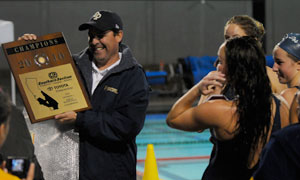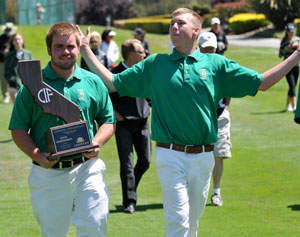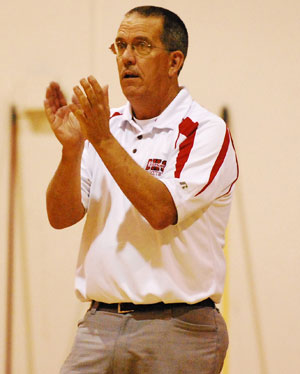Running a high school athletic program these days is like being a yoga master, an artist and a bean counter. You need to be flexible, creative and able to stretch a dollar.
As school districts are forced to slash budgets in this tough economy, the athletic directors at South Coast area high schools are scrambling to make sure their athletes and sports teams aren’t shortchanged on equipment, games and quality coaching.
It’s a challenging job that gets more challenging each year, especially in the public schools.
The athletic directors at Santa Barbara, San Marcos, Dos Pueblos and Carpinteria are all feeling the strain of running their programs with less money. They reach out to parents of athletes and the business community for financial support and encourage their coaches to do the same.
“It is very hard to provide the level of programs that people have come to expect with the money available,” said Carpinteria athletic director John Ward.
Nan Verkaik is the athletic director at the oldest public high school in the community, Santa Barbara High. She’s had to deal with some older facilities on campus that need to be repaired or replaced. The venerable Peabody Stadium, for instance, has been without a press box since 2002.
It’s matter of money, or lack thereof.
“The district is short on money, and facilities and equipment gets old and wears out. It has to be replaced, and it is expensive,” Verkaik answered in an email questionnaire sent out to local athletic directors by Presidiosports.com. “Things the district used to be able to cover, they can no longer cover.”

Dos Pueblos Athletic Director Dan Feldhaus, left, saw his Chargers win CIF titles in girls volleyball and girls water polo last year despite a tight budget, and added a CIF runner-up in boys soccer.
Abe Jahadhmy at San Marcos, Dan Feldhaus at Dos Pueblos and Ward concur with their colleague.
“We are tightening things down and asking parents to help carry more of the financial burden of running our athletic department,” said Feldhaus, who’s in his third year as AD at Dos Pueblos. “We have a great group of parents at DP and a large amount of community support willing to help out our school. At this point, we have not made any major cuts to any of our programs, but the cost of travel, tournament fees and equipment will factor into future decisions.”
Said Jahadhmy, “We have raised funds so that our programs have remained status quo. No cuts. Teams fund-raise for equipment, tourneys, uniforms and extra coaches not covered by district stipends. I fund raise for transportation, safety equipment and referees.”
Jahadhmy also is overseeing a fund-raising drive to replace the heavily used Valley Stadium grass field with a turf field.

Santa Barbara High had two of its teams excel to the highest levels last year. The Dons boys soccer team won a CIF title while the boys golf team won a State Championship.
Ward said he’s made some financial sacrifices to keep Carpinteria’s athletic budget balanced. One area he won’t touch, though, is the pay to coaches.
“We have not cut coaches’ salaries. I am adamant about that. In fact, I feel that coaches need to be paid more, but I will save that for another rant,” he said.
Athletes at Carpinteria are required to pay a transportation fee for each sport they participate in — the fee is reduced for each additional sport and aid is available for families that cannot afford the fee, Ward said. “We do not charge any other fees at this time.”
At the private schools, athletes can play without paying any fees. But, there is a matter of tuition.
At Bishop Diego, an independent Catholic co-education high school, there is a yearly tuition of $13,400 per student.
Athletic fundraising is handled by the school’s booster organization called the Cardinal Club.
Athletic director Dan Peeters has been spared the anguish of making cuts.
“There has been no cutting of funding to sporting programs, or stipends over my seven year tenure as AD at Bishop,” he said.
Meanwhile, at Cate School, it’s like old times as all funding of athletics comes out of the general school budget. Mind you, Cate, a college preparatory boarding school of about 300, has a tuition of $43,500 for boarders and $34,500 for day students.
Athletic director Wade Ramson noted, however, the school has become more conscientious about its spending when it comes to travel.
“We have started traveling with different teams together if their destinations are geographically close, in order to avoid multiple bus trips,” he said.
Verkaik admits it would easier in many cases to trim games and eliminate lower level programs to ease the budget crunch, but that’s not an option.
“It is still the best way to keep kids active, out of trouble and focused,” she said of interscholastic athletics. “I will do everything I can do to keep from cutting programs. We focus on learning goals, therefore every student-athlete is important to our athletic program and school.”
Another area where budget cuts are affecting public school athletic programs is in coaching.
Schools are losing good coaches due to layoffs, teachers giving up on coaching and quality walk-ons getting tougher to find and keep.
“Due to seniority issues, we lost two teacher-coaches this year,” Feldhaus said. “Our walk-on coaches are also feeling the pinch of cutting back their coaching time to make sure their day jobs are secure.”
He added, “When I was a student at DP in the ‘80s, most of the coaching positions were filled by DP staff members. Maybe someday we can go back to the days when more teachers were involved in extracurricular activities like coaching.”

Carpinteria Athletic Director John Ward is the boys basketball coach and is also a math teacher at the school.
Ward, who doubles as Carpinteria’s boys basketball coach, also has noticed the decline in on-campus coaches.
“Fewer teachers are interested in coaching than in the past, which means that there are more walk-on positions,” he said. “We are extremely lucky at Carpinteria in that many of our head coaches are teachers and the walk-on coaches we have are excellent.
“It is very difficult to find an outstanding coach who will sacrifice the incredible amount of time needed to run a successful program for the amount of money they get paid,” Ward continued. “A typical walk-on coach needs to be able to work three hours a day (usually in the afternoon), 5-6 days a week, for a period of three months, for approximately $2,000-$3,000. The other nine months a successful coach is still involved in his program, dedicating a lot of time and effort into all the things needed to keep a program working.”
With school districts cutting back on funding athletics, booster clubs are the saving grace for athletic directors and coaches.
Said Feldhaus, “At Dos Pueblos, due to the efforts of our school-wide athletic booster club, the Charger Associates, the athletic department will cover most travel expenses, the cost of officials and the game management cost for all our teams.”
It’s a collaborative effort at Carpinteria.
“We are very fortunate at Carpinteria High School in that we have great community support and a tremendous booster club,” Ward said. “Without the help from our boosters, we would have to make severe cuts in our athletic program. Most of our fundraising is done by the booster club. All of our individual sports are asked to help with the booster club fundraisers and are willingly doing it.”
Another issue some athletic directors face these days is athletes specializing in one sport.
“There’s been a subtle change in emphasis of many high school programs from values education through team participation to more of a ‘club’ sport mentality where playing time and college scholarships are the main emphasis,” Ward said. “(But) I do not blame a lot of parents and athletes with college education costing what is does nowadays.”
Peeters said with CIF Southern Section rescinding the association rule, which allows a coach to work with athletes outside their given season, schools will probably see more athletes sticking to one sport.
Fortunately, for the coaches at Bishop, the majority of their student-athletes participate in multiple sports.
“The coaches at Bishop understand we must share our student-athletes, and embrace this reality,” Peeters said. “I am proud that student-athletes at Bishop can fully enjoy their high school experience, and benefit from the experience of playing multiple sports.”
Ransom has an issue with specialization from a medical point of view.
With a background as a former trainer in the NFL (New York Jets) and at a Division 1 university, Ransom said he’s “seen the number of athletes whose bodies fall apart before, or in their college career, increase significantly over the course of the last 15 years. And one of the factors that seem to crop up time and time again is the year-round club sport participation.
“Of course, most kids will improve their skills with dedication and hard work all year long, but at what cost?”
It may seem like a laundry list of concerns, but this is what athletic directors deal with day in and day out.
It’s become a tougher job, but they continue to do it for the benefit of the kids.
